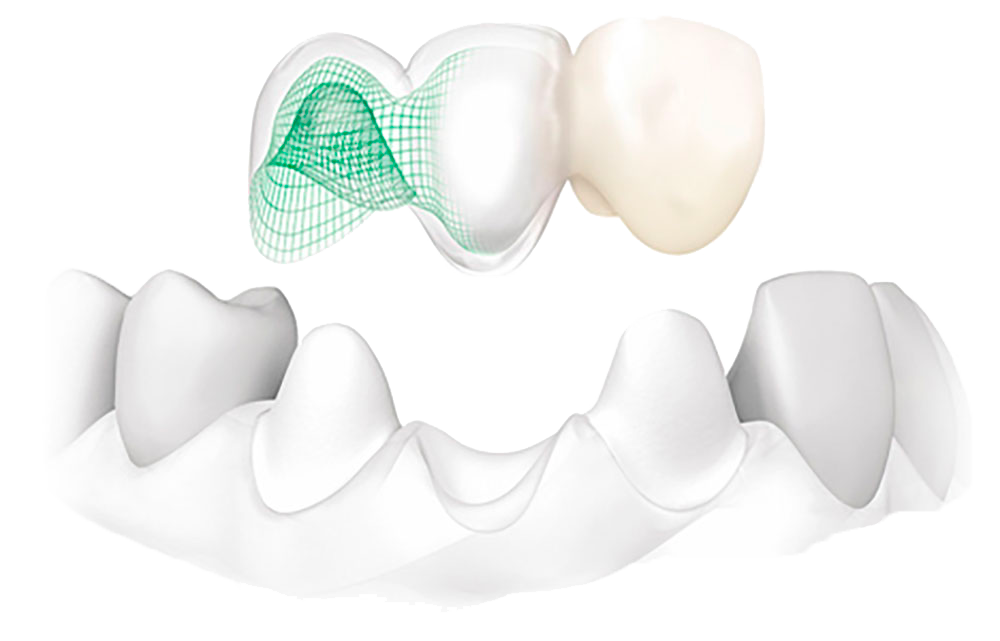Dental prosthesis

Why dental prosthesis?

When a tooth is badly damaged due to decay or trauma, it is necessary to restore it in a solid, aesthetic and waterproof manner. Depending on the degree of decay, an inlay-onlay or a crown can be used
Dental prostheses are also used to replace missing teeth. In addition to aesthetic considerations, it is essential to have all one’s teeth to ensure efficient chewing and to facilitate digestion.
The different solutions are dental implants, bridges and removable prostheses.

Inlay Onlay
The inlay-onlay are medical devices made by our craftsman-prosthetist.
Made to measure, they are glued to the tooth in order to replace the part destroyed by decay or by the melting of the enamel. It is an ideal cosmetic prosthesis for dental aesthetics.
Made of composite resin or ceramic, these prostheses reproduce the exact shade and shape of your teeth.
This technique is very economical with dental tissue. However, it is reserved for teeth that are relatively unaffected by decay.
What is a prosthetic dental crown?

A dental crown is a custom-made medical device designed to restore a tooth severely damaged by decay or trauma. It restores the natural shape, size, function and strength of the tooth.
Designed either in pure ceramic or ceramic-metallic (metal base and aesthetic ceramic on top), the crown is the reference technique for treating devitalized teeth.
The main advantages of a pure ceramic crown :
- EBiocompatibility: the gums are more tolerant of ceramic than metal: the risk of iatrogenic gingivitis is thus reduced.
- EIts aesthetics: by its intrinsic qualities, the ceramic crown has aesthetic qualities similar to natural teeth. Contrary to the metal-ceramic crown, this type of prosthesis eliminates the risk of "gray tattoos" that can appear on the gums. The ceramic crown remains the reference technique for a natural and durable cosmetic result.

Dental bridge
It allows for the replacement of one or more missing teeth by resting on the remaining teeth on either side of the tooth gap.
The dental bridge is the reference solution for replacing an edentulous tooth when the adjacent teeth are dilapidated or damaged. If this is not the case, it is preferable to opt for implants, which are more conservative.
Like dental crowns, it is possible to make a metal-ceramic bridge or an all-ceramic bridge.
Removable prostheses
Removable prostheses can be, as their name indicates, inserted and removed at will. They can be partial, with metal clasps around the remaining teeth, or complete (they replace all the teeth in an arch).
Design of the dental prosthesis
The production of complete removable prostheses requires a succession of very precise steps. In fact, two or more impressions are necessary to record the position of the gums, tongue, lips and cheeks very accurately.
Using the press studs:
In the lower jaw, when the toothlessness is total, the contact surface between the prosthesis and the gum is not sufficient. The prosthesis must then be stabilized with press-studs placed on dental implants.
The follow-up
When wearing a complete removable prosthesis for the first time, a period of adaptation is necessary, especially for eating. In the weeks following the fitting of the prosthesis, many adjustments may be necessary in order to perfect your morphology and ensure optimum comfort.
Over time, it is possible for the jawbone and gums to collapse and cause the denture to lose stability. This situation is remedied by performing a “reline”, which will fill the gaps between the prosthesis and the gum.
